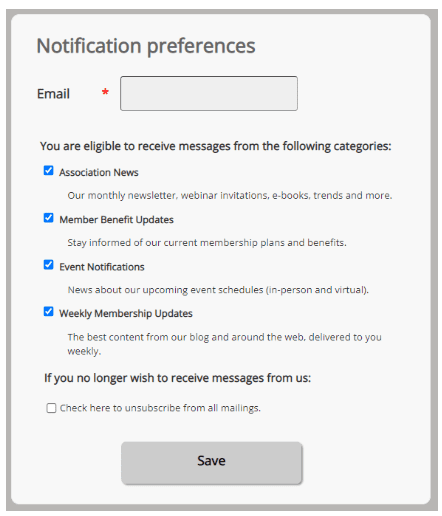
Safeguard Member Engagement Through Choice: Message Categories and Email Preferences
Your email program needs to allow for choice. Allow members to self-select what content they’re interested in and make it easier to track their subscriptions with message categories and preference management.
Personalization Pays Dividends
There’s a lot of content out there and most of us don’t have time to wade through things that aren’t interesting or relevant to us. Statistics show:
- Personalization has been shown to boost website conversions up to 300%. (Source: Epsilon)
- 91% of consumers are more likely to shop with brands that provide personalized offers and recommendations. (Source: Accenture)
- Personalized email campaigns have a 29% higher open rate and a 41% higher CTR than non-personalized ones. (Source: Experian)
Users reward brands that make the effort to know what they care about, and that don’t bother them with content that doesn’t interest them.
For associations, whose mandate eclipses that of retail brands when it comes to supporting members’ personal development and success, customizing your members’ experience is even more important to building authentic and trusted relationships.
Let People Opt-Out
We also know what a powerful tool email is for member communication. But inboxes are jam-packed and incoming generations to the workforce have less patience than ever for content they deem irrelevant. Even though your members willingly joined your association, that doesn’t mean they will find every email you send interesting or useful. Junk from a friend is still junk.
If you’re not willing to listen to your members about what they do and don’t want to receive, you will inadvertently train them to view your email as something they don’t really need to open. To protect the power of email, you need to be judicious about what you send, how often, and to whom.
That’s why tools/features like Higher Logic Thrive Marketing’s new message categories and preference management pages are so important.
Message categories allow you to (you guessed it) categorize the messages you send so you can allow your members to opt into (or out of) the types of messages they are most (or least) interested in. They do this via a preference management page (typically linked from your emails). This empowers your members to decide what emails from your association they value and enables you to easily manage opt-outs. When members opt into or out of your message categories, Higher Logic tracks that and acts accordingly. So, when you send a message to your full audience, or to a targeted subset of your email list, if they’ve unsubscribed from that specific message category Higher Logic Thrive Marketing automatically filters them out for you.
Bonus: the system can also generate reports broken down by message categories, allowing you to compare performance and effectiveness by message type (for example, comparing opens and clicks for newsletters vs. program-specific messaging).
Allowing members this level of control may seem scary at first – one of the first things many leadership teams ask is, “but what if members unsubscribe from all of our XYZ messages!” – but ultimately allowing members to make the choice for themselves helps you keep members in the fold. It’s better to have members unsubscribe from one category they’re not interested in than unsubscribe from all your communications.
Setting Up Message Categories
So where do you start when considering what message categories to offer your members? Ask yourself what variables your members might care most about and what you can act on.
Ideas for message categories that you might allow members to opt in or out of:
- Categories based on time:
- Allow members to set the schedule on which they receive email or offer them the option to choose between weekly, monthly, or quarterly newsletters/digests that aggregate your content
- Categories based on content type:
- Events
- Program Types (in-person, virtual, conferences, webinars, on-demand, certification)
- Topics of Interest
- Membership Updates
- Company Announcements
- Job Boards/Career Opportunities
- Partner Promotions or Offerings
Example: maybe you think your members want to weigh in on how often they receive email from your organization, but you don’t have a system in place that would allow you to control how often individual members receive emails. An alternative to try would be to offer a specific type of message that’s a weekly or monthly digest and allow members to opt into that in addition to or instead of your other targeted messages.

Internal vs. External Data and Segmentation
There could be some confusion about the relationship between message categories and the segmentation your association does that lives elsewhere in your tech stack. For instance, you might have personas set-up in a marketing tool that you use to segment your marketing lists when deciding who to send messages to. Or you might pull targeted lists based on certain criteria. The difference is internal vs. external, and these two types of segmentation/personalization can work in tandem.
Internal segmentation is something you do based on your data. This might include how long someone has been a member, their experience level in the industry, their website activity, the events they registered for, their renewal date, etc. Whether or not the member provided this information directly or you’re tracking it based on their behavior, it’s something you collect, store, and potentially act on to target your marketing.
Message categories, meanwhile, are the result of members externally and deliberately selecting what they do and don’t want to happen in their experience. Members take the initiative to keep these preferences updated.
How do you use them together? Let’s say you decide to send a marketing email about a webinar on the value of community to members who’ve shown interest in community before. Let’s say you also have message categories based on program types you offer (webinars, on-demand offerings, in-person offerings, etc.). When you send that message about your community webinar to the targeted list of community-interested members you created, Higher Logic Thrive Marketing will simultaneously exclude the individuals who’ve unsubscribed from the message category for webinars. So only those who are both interested in community and interested in webinars receive that email (though others may still hear about the webinar via your other channels like email digests or social media).
Design Tips for Your Preference Management Page
Once you’ve chosen your message categories, it’s time to level-up your unsubscribe page to a preference management page. And as with all online user experiences, the easier you make it for users to understand and use this page, the better:
Tip 1: Don’t bury your preference management link. Gone are the days of hiding your unsubscribe link at the bottom of your email, making it as small as possible hoping recipients won’t notice it. You need to make it easier for recipients to use your preference management link (which will at least give you data) than it is for them to use their email client’s unsubscribe settings (Gmail, for example, asks at the top of each email if the user wants to unsubscribe).
Tip 2: Only ask for data you are actually going to use and have the infrastructure to leverage. There’s no reason to burn up a members’ time asking them to do things for no reason. If you don’t have a plan for how to execute specific email frequency, for example, don’t ask members if they want to weigh in on that – it will just cause frustration because they’ll feel like you’re not listening to what they told you.
Tip 3: Throughout your onboarding and your members’ subsequent journey, make the benefits of and process for setting email preferences clear. Regularly remind members to set and update their preferences.
Tip 4: If possible, don’t require login/password, re-logins, or multiple hoops to jump through in order to access your email preferences page.
Tip 5: Conduct your own regularly scheduled maintenance and assessment of your message categories and preference management page. Is it still functioning as intended? Do the categories still align with what you send?
Tip 6: Ideally, your members should be able to manage all their info and preferences (not just their email preferences) in one place. But sometimes that’s not feasible, so at the very least make sure you’re transparent about where members can manage their info. If you have different portals where members update their account settings or their community digest email preferences, think about providing links to those from the email preference management page.
Summary
When you enthusiastically facilitate members’ ability to customize their experiences with your association, you increase their satisfaction and engagement, and ultimately improve member retention.
- Members assign more weight to the emails they get from you.
- They’ve optimized the time they spend with your content.
- They engage more in the topics they themselves selected.
- They’re receiving communications when they’re most likely to open and read it.
- They see your association as a helpful resource that respects their time and prioritizes their needs.
Facilitating choice by way of messaging categories and member preference pages sends all the right signals and ultimately helps your association improve member experiences and demonstrate value.

Higher Logic Thrive Makes Member Communication Easy
Learn more about how you can leverage message categories, preference management pages, and other Higher Logic Thrive marketing tools to make your member communication easy yet impactful.




